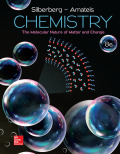
Concept explainers
Interpretation:
The
Concept introduction:
An equilibrium constant
For the general acid HA,
The relative strength of an acid and base in water can be also expressed quantitatively with an equilibrium constant as follows:
An equilibrium constant
Explanation of Solution
Given,
Solution of
Malonic acid is diprotic acid therefore it can donate the two protons to the water.
The balance equation is given below,
The formed
From the dissociation,
Therefore,
ICE table:
| Initial concentration | 0.2 M | - | 0 | 0 |
| Change | -x | + x | + x | |
| At equilibrium | 0.2-x | x | x |
The initial concentration is
Let consider,
Percent dissociation can be calculated by using following formula,
Percentage of error is high and it is not valid, the dissociation of
The quadratic formula is given below,
Hence,
Therefore,
The
Hence,
Therefore,
pOH of the solution is
The Malonic acid concentration at equilibrium is
The Malonic acid concentration at equilibrium is
The Malonic acid concentration at equilibrium is
Therefore, the
Therefore,
ICE table:
| Initial concentration | - | 0 | ||
| Change | -x | + x | + x | |
| At equilibrium | x |
X value is very small, hence not necessary to calculate the
Hence,
Want to see more full solutions like this?
Chapter 18 Solutions
EBK CHEMISTRY: THE MOLECULAR NATURE OF
 ChemistryChemistryISBN:9781305957404Author:Steven S. Zumdahl, Susan A. Zumdahl, Donald J. DeCostePublisher:Cengage Learning
ChemistryChemistryISBN:9781305957404Author:Steven S. Zumdahl, Susan A. Zumdahl, Donald J. DeCostePublisher:Cengage Learning ChemistryChemistryISBN:9781259911156Author:Raymond Chang Dr., Jason Overby ProfessorPublisher:McGraw-Hill Education
ChemistryChemistryISBN:9781259911156Author:Raymond Chang Dr., Jason Overby ProfessorPublisher:McGraw-Hill Education Principles of Instrumental AnalysisChemistryISBN:9781305577213Author:Douglas A. Skoog, F. James Holler, Stanley R. CrouchPublisher:Cengage Learning
Principles of Instrumental AnalysisChemistryISBN:9781305577213Author:Douglas A. Skoog, F. James Holler, Stanley R. CrouchPublisher:Cengage Learning Organic ChemistryChemistryISBN:9780078021558Author:Janice Gorzynski Smith Dr.Publisher:McGraw-Hill Education
Organic ChemistryChemistryISBN:9780078021558Author:Janice Gorzynski Smith Dr.Publisher:McGraw-Hill Education Chemistry: Principles and ReactionsChemistryISBN:9781305079373Author:William L. Masterton, Cecile N. HurleyPublisher:Cengage Learning
Chemistry: Principles and ReactionsChemistryISBN:9781305079373Author:William L. Masterton, Cecile N. HurleyPublisher:Cengage Learning Elementary Principles of Chemical Processes, Bind...ChemistryISBN:9781118431221Author:Richard M. Felder, Ronald W. Rousseau, Lisa G. BullardPublisher:WILEY
Elementary Principles of Chemical Processes, Bind...ChemistryISBN:9781118431221Author:Richard M. Felder, Ronald W. Rousseau, Lisa G. BullardPublisher:WILEY





